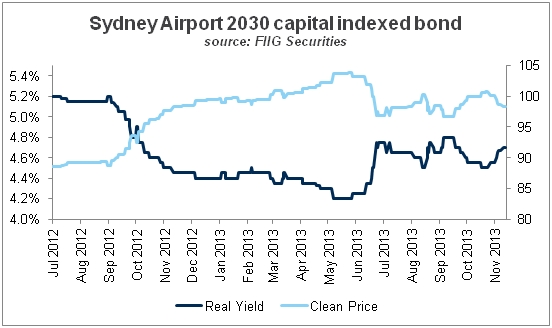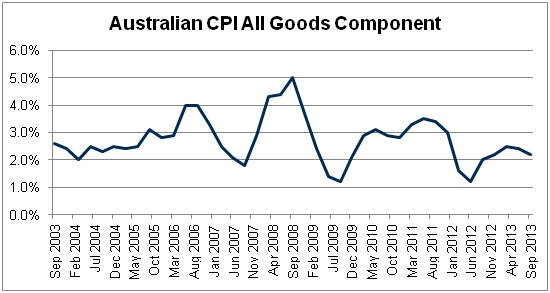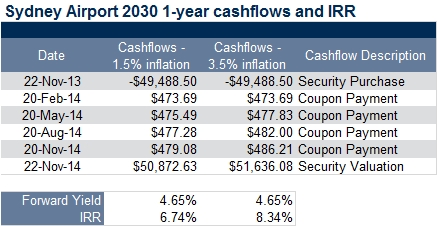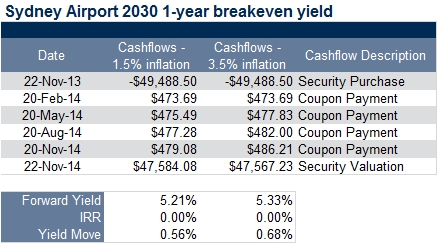From the Trading Desk – Break even analysis on Sydney Airport capital indexed bonds shows great value
Market commentary
By far the best value bond at the moment is the Sydney Airport 2020 and 2030 capital indexed bonds. The 2020 bond is currently offered at CPI+4.15% and the 2030 is offered at CPI+4.65%, translating into estimated yields around 6.65% and 7.15% respectively (assuming an average 2.50% inflation rate until maturity of the bonds).
A couple of weeks ago I wrote suggesting that certain bonds issued by Morgan Stanley, ING Bank, and AMP Bank appeared overvalued (see Sell Financials). Since then the AMP bond has backed off around 10-15 basis points after the issuer announced a new subordinated debt offering at a much higher margin of 265 basis points over BBSW, but the ING Bank and Morgan Stanley bonds are still well bid, even after a negative ratings move on Morgan Stanley by ratings agency Moody’s Investor Services. We still view these bonds as overvalued and recommend investors switch into alternative fixed income assets.
Sydney Airport break even analysis
Key points:
Sydney Airport capital indexed bonds offer outstanding value as a result of market uncertainty regarding inflation.
Best and worst cases for inflation still result in attractive returns on these bonds.
Breakeven yields are far beyond levels ever seen.
I’m not normally one to repeat myself unnecessarily; however, as I pondered ideas for this week it became clear that my chosen topic is the confluence of two recent articles. In September I discussed the recent underperformance of Sydney Airport capital indexed bonds as a result of anticipated changes to economic policy in the US (see Sydney Airport recent price performance). Then in October I wrote about how high-yielding bonds bear up under adverse market conditions due to the income on the investments (see High yield bonds fare well in stress tests).
Inflation linked bond prices continue to be dragged down by global inflation uncertainty in the market, and the Sydney Airport bonds are no exception (see Figure 1). I will use the bond maturing in 2030 in my analysis in this article, but both the 2020 and the 2030 bonds represent very good value.

Source: Bloomberg/ FIIG Securities
Figure 1
The nervousness in the market concerning global inflation notwithstanding, the Reserve Bank of Australia has done a reasonably good job keeping the local inflation rate contained within a band of 2% to 3% historically, with the risk weighted toward the high side rather than the low side of the band (see Figure 2).

Source: Bloomberg/ FIIG Securities
Figure 2
In Table 1 below, we examine theoretical internal rates of return (IRR) on the Sydney Airport 2030, using high and low assumptions for Australian inflation over the next year of 50 basis points outside the RBA band (i.e. 1.50% and 3.50%). In each case, the bond is valued out of the forward date at the same level for which it is available today (CPP+4.65%). The best and worst case IRR on the investment under these scenarios is 6.74% and 8.34% respectively.

Table 1
If we use the same assumptions over two and three years, the worst/best case IRRs are 6.53% / 8.39% (two years) and 6.45% / 8.40% (three years).
However, this is only the first part of our analysis. The purpose of this article is to highlight how far from here yield must drift to reach a breakeven level (the level where your IRR turns negative) after one, two, and three years. As shown in Table 2 below, these levels in the high and low inflation scenarios are 5.21% (56 basis points higher) and 5.33% (68 basis points higher).

Table 2
Again, using the same assumptions over two and three years, we find the worst/best case breakeven yields are CPI+5.81% / CPI+6.13% (two years) and CPI+6.51% / CPI+7.07% (three years). Given that the highest real yield I have ever seen since I began watching this security was CPI+5.85% back in August 2011, it seems unlikely that a three-year breakeven point will be reached under normal circumstances.
My conclusion and message to clients is two-fold. If you are a holder of these bonds, be patient and you will be rewarded. If you are not a holder, then you should give serious consideration to adding them to your portfolio.
Key terms
Capital indexed bonds (CIB)
A bond whose base payment rises and falls with the CPI.
Real Yield
The margin over CPI yielded by a security, normally quoted in quarterly terms.
Internal rate of return (IRR)
The discount rate that makes the net present value of all cash flows from a particular project equal to zero. The formula for calculating IRR is an iterative one, where a rate is sought that satisfies the following formula:

where:
Pi = the ith payment
Di = the ith payment date
D1 = the first payment date